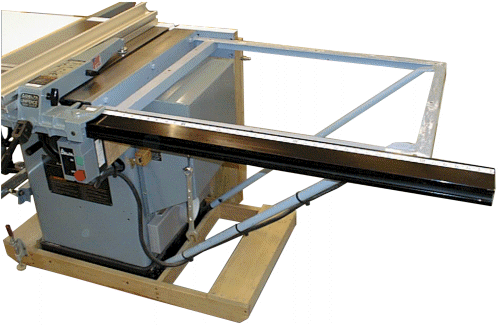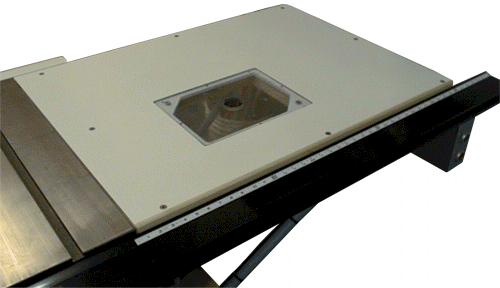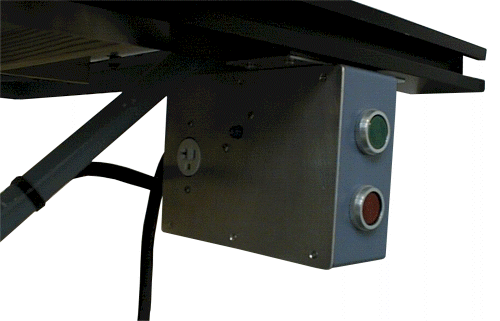|
|
|
Unisaw Extension Table
The Unifence
requires an extension table on the right of the saw to operate. |
| This view shows
the framework that the right extension table is attached to. It is made of 1
1/2" angle iron, flat bar stock and round tubing. The angle iron is welded to
the flat bar stock which is bolted to the iron saw table. The tubing is welded to
the saw cabinet and to the angle iron. By supporting the right extension with the
saw itself, separate support legs are not needed. Since I wanted the saw to be
mobile, it is beneficial not to have legs that would need to be adjusted or folded when
the saw was moved. Also visible in this view are several other modifications; I extended the power switch out so it would be easier to operate, the saw it fitted with a folding outfeed table (shown folded), and a shop-made mobile base. The mobile base is important because with this type of extension table, the center of gravity of the saw is moved towards the right by enough that the saw can be more easily tipped in that direction. To solve this, I made a mobile base to lengthen the footprint - there is no danger of tip with this base. |
|
 |
The extension table is bolted to the angle iron frame but the table does not rest directly on the frame. The bolts are used to micro-adjust the table surface to be level with the iron table. |
| The table itself it made of 3/4" Melamine that is edge banded with hardwood, the leading edge near the rip fence rail is also beveled. The 3/4" is not sufficiently strong for the extension, to increase the strength, a pine sub-frame is attached to the bottom. The reasons for using Melamine were: it's cheap and when I made this particular table, I had already ordered the Hammer B3; Melamine is also flat and stable. If I were to make one of these again, I would use laminate or Corion. | |
The extension table also serves as a router station. The insert is leveled flush with the surface with a series of set screws. The Unifence is used as the router fence, the aluminum fence is removed and replaced with a custom router fence when the router bit needs to be buried. |
 |
| This cut-away section is at the junction of the right edge of the main saw table. The angle iron support is attached to the saw using three bolts run into the same holes that would be used to attach a standard extension wing. The extension table is attached to the angle iron support frame using eight bolts. These bolts allow the table surface to be very accurately aligned with the height of the main saw table. Since the table surface is only 3/4" thick, it needs support to keep it flat. To accomplish this, framework is attached to the underside of the table, this frame sits inside the perimeter of the angle iron supports. |
|
| As a convenience, I wired up a power point for the router. The Unisaw runs on 220v and routers nearly all run on 110v. The power cord was brought into this junction box. A 220v line continues to the saw from here but one of the 220v legs is wired to the receptacle shown through the switch and 15a breaker on the box to provide 110v for the router. |  |